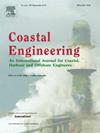Minutely monitoring of swash zone processes using a lidar-camera fusion system
IF 4.2
2区 工程技术
Q1 ENGINEERING, CIVIL
引用次数: 0
Abstract
The advancement of effective remote sensing technologies is critical for understanding the dynamics of coastal systems, enabling efficient and sustainable management strategies. Video cameras have been widely used for this purpose, significantly advancing our knowledge of coastal dynamics. However, traditional optical devices cannot directly provide three-dimensional (3D) information, such as beach profiles or runup heights. Recently, lidar scanners have gained attention within the coastal research community for their ability to directly capture high-resolution data on hydro-sediment interactions near shorelines across various scales, providing valuable insights into coastal dynamics. This study presents a fusion system that combines a 3D lidar with a video camera, capable of simultaneously capturing 3D coordinates and surface colors of beaches and nearshore waves. The fusion system was tested at two coastal sites in Japan, demonstrating its high potential for coastal monitoring. At the Hasaki coast, characterized by fine sand, it captured alongshore variations in topographic changes, linked to runup heights and seepage processes over one day. At the Namiita coast, characterized by a mixed sand-gravel beach, the fusion system observed the development of cusp structures over 3 h. The data suggest sand accumulation around gravel and gravel retrieval from the beach surface following an increase in tide level. Although this fusion system was tested at only two coastal sites in Japan, it demonstrates high flexibility and potential for studying swash zone processes across diverse spatiotemporal scales and beaches, including mixed sand-gravel beaches.
利用激光雷达-摄像机融合系统对冲积区过程进行细致的监测
有效遥感技术的进步对于了解沿海系统的动态,实现有效和可持续的管理战略至关重要。摄像机已被广泛用于这一目的,大大提高了我们对海岸动力学的认识。然而,传统的光学设备不能直接提供三维(3D)信息,如海滩轮廓或上升高度。最近,激光雷达扫描仪已经引起了沿海研究界的关注,因为它们能够直接捕获海岸线附近各种尺度的水-沉积物相互作用的高分辨率数据,为海岸动力学提供了有价值的见解。本研究提出了一种融合系统,该系统将3D激光雷达与摄像机相结合,能够同时捕获海滩和近岸波浪的3D坐标和表面颜色。该融合系统在日本的两个沿海站点进行了测试,显示了其在沿海监测方面的巨大潜力。在以细沙为特征的Hasaki海岸,它捕捉到了沿岸地形变化的变化,这些变化与一天内的上升高度和渗透过程有关。在纳米田海岸,以混合沙砾海滩为特征,融合系统在3小时内观察到尖状结构的发展。数据表明,随着潮水的增加,砾石周围的沙子堆积和砾石从海滩表面回收。虽然该融合系统仅在日本的两个沿海地点进行了测试,但它显示了高度的灵活性和潜力,可以研究不同时空尺度和海滩(包括混合沙砾海滩)的冲水带过程。
本文章由计算机程序翻译,如有差异,请以英文原文为准。
求助全文
约1分钟内获得全文
求助全文
来源期刊

Coastal Engineering
工程技术-工程:大洋
CiteScore
9.20
自引率
13.60%
发文量
0
审稿时长
3.5 months
期刊介绍:
Coastal Engineering is an international medium for coastal engineers and scientists. Combining practical applications with modern technological and scientific approaches, such as mathematical and numerical modelling, laboratory and field observations and experiments, it publishes fundamental studies as well as case studies on the following aspects of coastal, harbour and offshore engineering: waves, currents and sediment transport; coastal, estuarine and offshore morphology; technical and functional design of coastal and harbour structures; morphological and environmental impact of coastal, harbour and offshore structures.
 求助内容:
求助内容: 应助结果提醒方式:
应助结果提醒方式:


